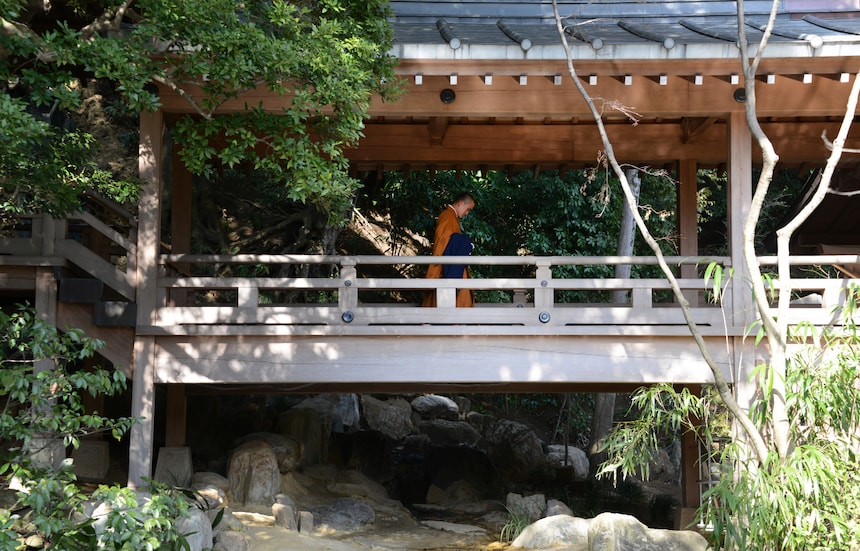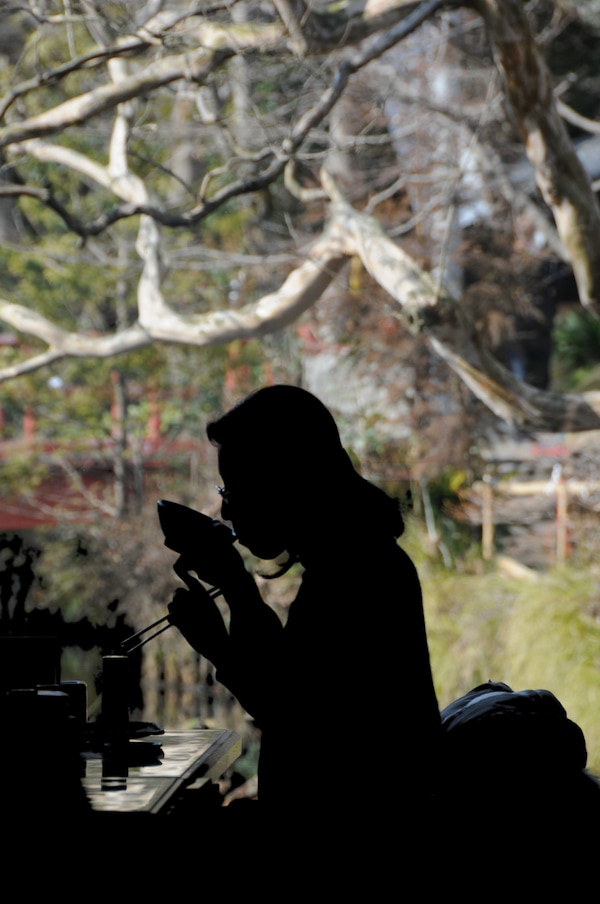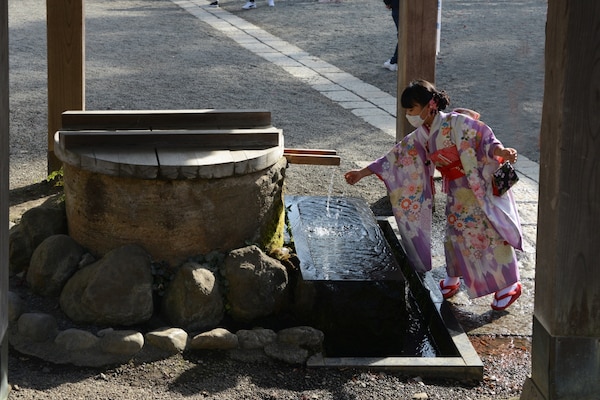Jindaiji Temple and Environs: Hidden Historical Gem Not Far From Central Tokyo

Photo by Andrew Pothecary.
A short hop from the center of Tokyo is the traditional neighborhood of Jindaiji, a pleasant area with Tokyo's second oldest temple, appealing soba shops, a shop celebrating the beloved artist Mizuki Shigeru, and more. Tokyo historian Mark Schreiber describes a tour covering its highlights.
Most itineraries for visitors to Tokyo include a stop at Asakusa's Sensoji temple. It's not only the city's oldest Buddhist temple, but enjoys the status of being one of the top tourist attractions. Visitors come for a stroll on Nakamise, the street leading from the huge Kaminarimon gate, lined with dozens of colorful shops selling every manner of Tokyo souvenir. The lively district around the temple still embraces the distinctive spirit of Tokyo's shitamachi (old town) culture.
But I'm here to extoll the treasure that is Jindaiji, Tokyo's second oldest Buddhist temple. Aside from its age (it was founded in 733 by the Tendai sect), it can be described as almost the polar opposite of Sensoji. Instead of the loud colors and packed shopping streets of Asakusa, Jindaiji—the temple and the district—offer lush greenery, peace and quiet, and a scenic and relaxing atmosphere all year round.
Here's a step-by-step account of a relaxing tour around one of my favorite Tokyo neighborhoods.
"Lush greenery, peace and quiet, and a scenic and relaxing atmosphere all year round."
Four train stations have buses that terminate near the temple's main gate. I'd recommend taking the Keio line train to Tsutsujigaoka, and the Keio Bus from there for several reasons. It's a small station and less confusing, and the buses run frequently (6 to 9 times per hour on weekdays) all day long.
Turn left after exiting the wicket and descend the escalator to street level. Walk past the florist at the bottom, turn left and veer to your right for 20 meters to the Jindaiji bus stop.
On the way the the temple, the bus makes a stop at the Jindai Botanical Gardens, but let's leave this to later.

Shoppers in kimono at the shop devoted to the work of artist Mizuki Shigeru. (Photo by Andrew Pothecary)
The first thing you'll see when disembarking at the temple is a large map of the area. Immediately on your left is a shop and teahouse devoted to the works of Mizuki Shigeru (1922–2015), an award-winning manga and anime artist beloved by fans of all ages. Although he hailed from Osaka, Mizuki set up a studio near here where he lived for half a century.
While serving as a soldier in the Japanese Imperial Army in Papua New Guinea, Mizuki lost his left arm. Fortunately he had an amazing talent for illustration, and through the media of manga he related the horrors of war based on his personal experiences.
Mizuki is best known for portrayals of yokai (a kind of spirit monster)—strange and slightly scary but lovable supernatural creatures that frequently interact with humans, especially children.
Beside the gift shop selling stationery and other merchandise featuring Mizuki's most popular manga characters, the Kitaro Chaya (tea house) can be immediately recognized by the pair of enormous yellow geta (wooden clogs) atop the roof.
GeGeGe Kitaro Chaya Website
"The local peasants once made offerings of the buckwheat they grew to the temple instead of the traditional rice."

Woman finishes her bowl of soba at a Jindaiji area shop. (Photo by Andrew Pothecary)
Continue walking and you'll see, at the top of the stone steps, the sanmon, the main gate of the temple. Before that on your left is Shimadaya, a soba buckwheat noodle restaurant founded by the Shimada family in the Bunkyu era (1861–1864). It is very much worth a stop, regardless of the time of day. It is one of some 18 buckwheat noodle restaurants that dot the area, each offering slightly different dishes, flavors and ambiance.
Soba differs from ramen, udon, Chinese and other varieties of noodle in that the noodles' main ingredient is buckwheat, which is not a grain like wheat, but a seed with a high starch content. It incorporates protein, dietary fiber, B vitamins and several minerals, including magnesium, manganese and phosphorus.
Originally the spring water here made it ideal for cultivating buckwheat, and the local peasants made offerings of the buckwheat they grew to the temple instead of the traditional rice. The priests and monks at the temple used the buckwheat to prepare soba noodles to serve to their guests, and the temple became known for its noodles.
Bamboo woven soba plates drying in the sun at a Jindaiji soba shop. (Photo by Andrew Pothecary)
Buckwheat noodles can be consumed cold served on a zaru (bamboo strainer), accompanied by shaved leeks and wasabi. Mix these into the tsuyu (dip), and dip the noodles before eating.
At no extra charge you can request soba-yu, served in a small lacquered vessel resembling a teapot. This contains the broth in which the noodles have been boiled, which can be mixed with the remaining tsuyu to make a nutritious soup to be consumed at the end of the meal.
Shimadaya has an English menu. It also serves non-noodle items such as konnyaku dengaku (a gelatinous root vegetable flavored with sweet miso paste) and oyaki (dumplings stuffed with pumpkin, mushrooms or salted vegetables). Wash it all down with a chilled Jindaiji Biiru, the locally brewed craft beer.
Shimadaya
5-12-10 Jindaiji Motomachi, Chofu
"Behind and on the sides of the temple area are inviting pathways along the hillside that beckon visitors to take a stroll through nature."

Ringing the temple bell at Jindaiji. (Photo by Andrew Pothecary)
The stone steps at the end of the approach road from the bus stop lead to Jindaiji temple's thatched-roof sanmon, literally "mountain gate," which is the oldest surviving structure in the temple, dating back to 1695.
Inside the gate and to its immediate right is the shoro or Bell Tower. Temple bells originally served the purpose of announcing the time. The Bell Tower to the right of the Main Gate is fairly new, having replaced a predecessor that was cast in 1376. That original bell, which boasts the distinction of being the oldest bell in the Tokyo region to have been used continuously since installation, is lovingly stored in the Shaka Hall to the left beyond the Main Gate.
Jindaiji's Hondo or Main Hall dates back to 733. The current edifice was built in 1919 after its predecessor was destroyed by fire.

Young woman washing hands in purifying water at Jindaiji temple. (Photo by Andrew Pothecary)
To the left of the Hondo is the Ganzandaishi Hall, which houses a statue of Hakuhoh Buddha. The oldest of its kind in eastern Japan, the statue was discovered buried beneath the stage of the Ganzandaishi Hall, and has since been designated a National Treasure.
The grand-master Ganzan Daishi, whom the statue commemorates, is reputed to have created omikuji, the fortune-telling slips) that are practically ubiquitous at temples and shrines throughout Japan.
Behind and on the sides of the temple area are inviting pathways along the hillside that beckon visitors to take a stroll through nature. Near the bottom of the steps leading up to the main gate you'll see a small pond. Turn to your left and walk a short distance (if you reach the large water wheel on your right you've gone too far), until you come to a pathway sloping up the hill. About halfway up is a stone staircase on the left that leads to an elaborate columbarium storing funeral urns of beloved pets. The graves form a half circle around a high tower.
Buddhism respects the souls of all living things, and you're an animal lover you might find a stroll around this temple a moving experience. (If you arrive during a funeral service, it's probably wise to back off and postpone your visit.)
Jindaiji Temple Website
Other Points of Interest: Jindai Botanical Gardens
The carefully tended green expanse of Jindai Botanical Gardens. (Photo by Andrew Pothecary)
This is a spacious park, famous for its spring season rose festival. Many native species of trees, including Japanese cherry, can be seen throughout the year. Formerly a nursery, it was converted to a botanical garden in 1961 and features 30 separate areas where different types of plants and trees are grown.
The Gardens are closed on Mondays except when a national holiday falls on a Monday, in which case it is closed the day after. Opening hours are 09:30 to 17:00; the ticket window closes at 16:00. Admission for adults: ¥500 (half for seniors)
Jindai Botanical Gardens Website
Yamori no Sato Hot Springs
Across the street from the temple is a mineral onsen hot springs called Yumori no Sato. In addition to bathing facilities and therapeutic massages, visitors can dine in a Japanese-style restaurant on the second floor (from noon to 21:30). Prices are quite affordable: The free access to the bath course is an inexpensive ¥1,080 on weekdays, and ¥100 higher on weekends. Hours of operation are from 10:00 to 22:00.
Yamori no Sato Onsen Website
Jindai Castle Ruins
If the weather is fine and you've got time to spare, you can explore the remnants of Jindaiji castle. During Japan's era of warring states, a rivalry developed between two important clans, the Uesugi and the Hojo. After the action shifted to another area, the castle was abandoned but not completely forgotten. The ruins are located in a wooded area just to the east of the main parking lot. There's not really much to see but sloping, grass-covered earthworks and markers where the foundations were laid. Still, it's a reminder that even in ancient times, at least some people felt that Jindaiji was worth fighting for.



